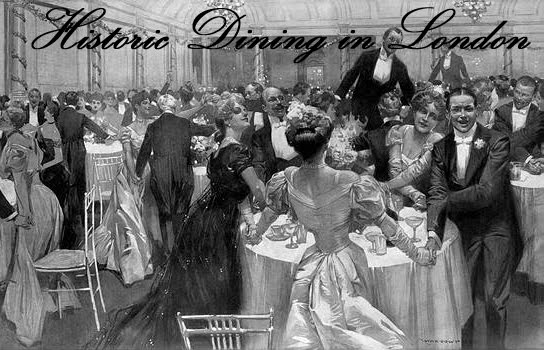Kettner’s is an important restaurant for me. It was on a rainy night at Kettner’s that I was inspired to champion the most historic eateries of London. I had read some short-sighted reviews from the most indecorous and bearded of London’s reviewers who had clambered onto the bandwagon of decrying the splendid efforts of both the owners and the interior designer Ilse Crawford in returning this historic restaurant to the sort of candle-glowing, palm-potted, piano-tinkling plac e it surely once was. Before this restoration, it had been a dreadfully seedy pizza parlour catering for the sort of perfunctory, pre-theatre printed t-shirt crowd who stared blankly at the carved cherubs and intricate Rococo panelling. Thank heavens, in my opinion, that it has been taken on by someone of taste and turned into what I consider a perfect late-Victorian oasis in the increasingly dubious but still exciting district of Soho.
e it surely once was. Before this restoration, it had been a dreadfully seedy pizza parlour catering for the sort of perfunctory, pre-theatre printed t-shirt crowd who stared blankly at the carved cherubs and intricate Rococo panelling. Thank heavens, in my opinion, that it has been taken on by someone of taste and turned into what I consider a perfect late-Victorian oasis in the increasingly dubious but still exciting district of Soho.
Original panelling and cornicing has been repainted, antique lighting has been carefully sourced, and a predominantly English staff hurry to and fro in the classic brasserie uniform of black trousers, white shirts and black ties. The only music you ever hear comes from the pianist tucked away from the main dining room; a room which is surrounded by the bright lights of Soho, being glazed on two of it’s four sides. There is no doubting Kettner’s is a romantic restaurant. Edward VII liked to meet Lillie Langtry here after her performances in one of the nearby theatres and it is said that Oscar Wilde and Lord Alfred ‘Bosie’ Douglas dined here frequently, although the assertion in the menu that Mr Wilde was arrested at Kettner’s is incorrect – he was arrested in Belgravia at the Cadogan Hotel. Other stories of Agatha Christie, Noel Coward and other luminaries of the stage and screen are connected with Kettner’s.
History is Kettner’s currency. Like the Criterion, the food is merely a supporting act. The mirrored and panelled walls, corniced ceiling and secret doorways are worth more than a Michelin star. This is an establishment of scandal, of Victorian fashion and of twentieth century decline. Opened in 1867 by Auguste Kettner, formerly chef to Napoleon III of France, it debuted at a time when French cuisine and culture were beginning to be the fashion in London. The French were no longer the black-toothed, cross-channel revolutionaries of the early 19th century. The Second Empire had silenced the Republic and had seen the transformation of the French capital from “dirty, crowded, damp and fetid streets… filled with the signs of poverty” to Haussmann’s bourgeois boulevards. Charles Worth, an English couturier, had set up his famous couture house in Paris in the previous decade and ‘French fashions ’ were de rigueur.
’ were de rigueur.
Kettner had arrived just in time. His kitchens became famous for serving what was considered to be, at the time, experimental and unusual cuisine. Lauded for his skill, the popularity of Kettner’s grew. Today’s edible incarnations do not offer the same kind of thrill that Kettner brought to London but they are wholesome, unpretentious and full of flavour.
The m enu plays up to the atmosphere with historic nods to French cuisine (Fish Soup, Rouille & Croutons and Beef Bourguignon) and there are even quirky illustrations that bear strong stylistic similarities to the Victorian artist Aubrey Beardsley. Kettner’s is a grand place. Refreshingly conscious of what it is and what it was. Too many places in London attempt to shrug off the great days by reinvention and even reclassification; painting over the stucco and plastering the cornicing, dragging in a velvet chair here, an appalling modernist print there. I like that Kettner’s is humble enough to acknowledge that it is not a place of fashion or self-satisfied haute cuisine and I respect that it pays homage to an era of previous greatness.
enu plays up to the atmosphere with historic nods to French cuisine (Fish Soup, Rouille & Croutons and Beef Bourguignon) and there are even quirky illustrations that bear strong stylistic similarities to the Victorian artist Aubrey Beardsley. Kettner’s is a grand place. Refreshingly conscious of what it is and what it was. Too many places in London attempt to shrug off the great days by reinvention and even reclassification; painting over the stucco and plastering the cornicing, dragging in a velvet chair here, an appalling modernist print there. I like that Kettner’s is humble enough to acknowledge that it is not a place of fashion or self-satisfied haute cuisine and I respect that it pays homage to an era of previous greatness.
Most of all, I bally well love eating here.
29 Romilly St. Soho, London W1D 5HP











